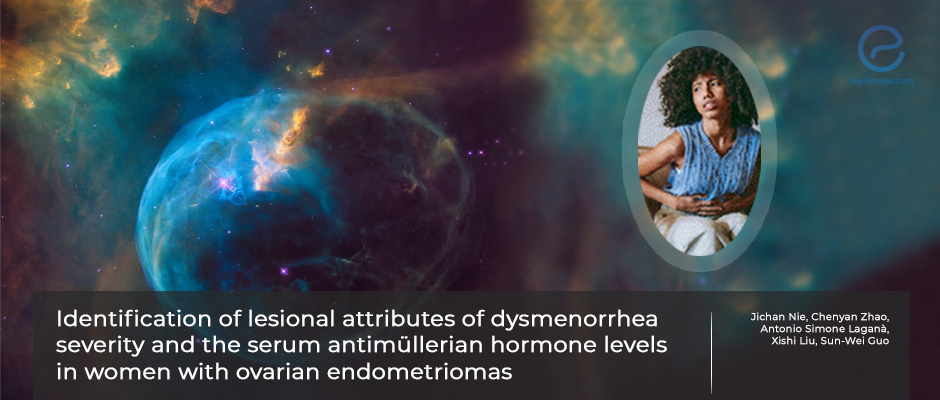Endometrioma and its relation with fibrosis, dysmenorrhea, and AMH levels.
Jul 29, 2022
Fibrosis is associated with pain severity
Key Points
Highlights:
- In women with endometrioma, the severity of dysmenorrhea is positively correlated with the extent of lesional fibrosis.
Importance:
- The study analyzed the relation between fibrosis, pain severity, and AMH levels.
- The results showed that the women with severe dysmenorrhea had fibrosis in the ovarian tissue surrounding endometrioma.
What's done here:
- A total of 313 patients who underwent laparoscopic endometrioma removal with the stripping technique have been included.
- Demographic data, day of menstruation at the operation, the severity of pain, the presence of other gynecologic diseases (adenomyosis, myoma, peritoneal endometriosis, deep infiltrative endometriosis), size and laterality of the endometrioma, AMH levels concomitant with FSH and LH levels before surgery and ASRM stages have been noted.
- For tissue analysis, routine hematoxylin-eosin, and markers of recurrence (phosphorylated nuclear factor kB p65 subunit, progesterone receptor isoform B, Slit2) immunostainings have been applied.
- In order to show cortical and central fibrosis, histochemistry on the tissues has been used.
- The authors defined fibrosis in two ways. First the fibrosis on the cyst itself (lesional fibrosis), and second, the fibrosis on the ovarian tissue surrounding the cyst.
Key Results:
- The level of lesional fibrosis has been found to be positively correlated with the severity of dysmenorrhea but not with serum AMH levels or to the ASRM scores.
- The AMH levels were significantly and negatively correlated with age and the extent of fibrosis in the ovarian cortex neighboring the endometrioma.
- A negative association between the pain scores and Progesterone receptor-B; positive links between dysmenorrhea and the recurrence markers, and a positive correlation with the accompaniment of peritoneal endometriosis have been shown.
Limitations:
- The results should be reevaluated with cross-sectional and long-term recurrence-based studies.
Lay Summary
Endometrioma is an indicator of endometriosis which makes it easy to diagnose the disease for most clinicians. But the symptoms and relationship of endometrioma with menstrual pain severity and the ovarian reserve as well as its markers are not well known.
In the study conducted by Jichan Nie et al., the authors questioned the relationship between ovarian fibrosis at the endometrioma site, the level of AMH levels, and the severity of dysmenorrhea. A total of 313 patients who underwent laparoscopic endometrioma removal with the stripping technique have been included in the study. Demographic data, menstruation properties, the severity of pain, the presence of other gynecologic diseases such as adenomyosis, myoma, peritoneal endometriosis, deep infiltrative endometriosis, the size and laterality of the endometrioma, AMH levels concomitant with FSH and LH levels before surgery and ASRM stages have been noted.
For histopathological tissue analysis, apart from routine hematoxylin-eosin sections, several immunostaining markers were applied. Progesterone receptor isoform B, p-p65, and Slit2 have been chosen as the markers of recurrence. In order to show cortical and central fibrosis, Masson Trichrome histochemistry has been used. The authors defined fibrosis in two ways. First, the fibrosis of the cyst itself (called lesional fibrosis); second, the fibrosis on the ovarian tissue surrounding the cyst.
The level of lesional fibrosis has been found to be positively correlated with the severity of dysmenorrhea, but not with serum AMH levels or the ASRM stage. The AMH levels were significantly and negatively correlated with the age and the extent of fibrosis in the ovarian cortex neighboring the endometrioma. There was a negative association between the pain scores and Progesterone receptor-B expression; a positive link between dysmenorrhea and the recurrence markers, and a positive correlation with the accompaniment of peritoneal endometriosis has been shown.
The authors concluded as this is a good start for future studies to find a marker that will show us a quantitative value of pain and lesional fibrosis. This article was recently published in the July issue of the journal named Fertility and Sterility.
Research Source: https://pubmed.ncbi.nlm.nih.gov/35641324/
fibrosis endometrioma amh Antimüllerian hormone; dysmenorrhea; ovarian cortex;

